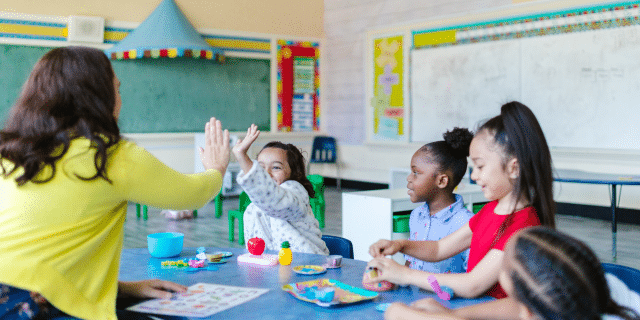The countdown to summer is on, and your students can feel it. But before the final bell rings, there’s still learning to do and a classroom to keep on track. Year-end chaos doesn’t have to rule the day. With a few clever classroom management tricks, you can keep your students focused, your sanity intact, and maybe even end the year with a few laughs. So, how do you wrap things up without unraveling? Let’s dive into some fun and effective year-end strategies that make the finish line feel just as rewarding as the start.
Stay Consistent with Behavior Expectations
The end of the school year brings special events, assemblies, and field trips that can throw off your regular schedule. While flexibility is important, maintaining consistency with your classroom expectations is key. Students, especially younger ones, find comfort in routine. Continue using your classroom signals, reinforcement systems, tools and apps, and behavior expectations just as you have all year. It might be tempting to ease up, but consistency helps students feel secure and keeps the classroom running smoothly. Reinforce positive behavior with praise or small incentives and apply logical consequences when needed.
Ease Up on the Curriculum (But Keep It Meaningful)
By now, the heavy lifting of academic instruction is complete. Use the final weeks to reinforce what students have learned while allowing space for creativity and fun. Consider interest-based research projects that allow students to explore topics they’re passionate about. These not only keep students engaged but give them ownership of their learning. Let your budding marine biologist create a poster about sharks or have your history buff do a skit about a famous figure. Make the extra minutes count with sponge activities. You’re still teaching — just with more flexibility.
Keep It Interesting with Creative Activities
When attention spans are short, engaging activities are your best friend. Incorporate group work, hands-on projects, and learning games. Older students might enjoy real-world skill building like budgeting, resume writing, or mock interviews. For younger students, try a classroom economy where they earn play money for positive behaviors and redeem it at an end-of-year sale. Offer choices in projects to boost motivation. Something as simple as switching from notebook paper to butcher paper for taking notes can spark renewed interest. You can even turn biography projects into interactive presentations — students decorate a poster with cut-outs representing their person, then cut a hole in it and present in character.
Create Calm with Mindfulness and Movement
As excitement builds, a few quiet moments can go a long way. Set the tone with mindfulness techniques like deep breathing, guided imagery, or soft background music. These tools are especially helpful after lunch or recess when students need help transitioning back to learning. Add in brain breaks, stretching sessions, or short walks to keep energy flowing in a positive direction. You’ll be surprised how a few minutes of calm can re-center the whole class.
Tackle Specific Year-End Challenges
Excessive talking? Acknowledge the excitement and give students a timed break to chat — then bring them back to task. Incomplete work? Consider whether the assignment still serves a learning purpose. If not, try offering a creative alternative — like writing a script for a Reader’s Theater performance instead of a traditional book report. Low motivation? Set small, daily goals and celebrate their completion with simple rewards like stickers, certificates, or a few extra minutes of recess.
Use Rewards Strategically
The right incentive can make all the difference. You don’t need to spend a lot — students love extra recess, a snack, and time outside. One fun idea is to assign two “secret agents” each day to watch for a specific behavior, like teamwork or staying on task. At the end of the day, the agents share who stood out and those students receive a reward. It builds community while reinforcing expectations. You can also try bubble rewards: place a small bottle of bubbles on each desk in the morning, and students who follow the rules get to blow them at the end of the day.
Reflect and Celebrate
Take time to honor the year you’ve spent together. Invite students to write memories from the year, then read them aloud as a class guessing game. Gratitude journals or letters to next year’s students can help your class process their growth and reflect on positive experiences. Not only does it provide closure, but it also promotes gratitude and emotional literacy.
Get Organized with Student Help
Take advantage of your eager helpers! Assign students to help organize the class library, check supplies, or make sure all the pieces are in the board games. Turn it into a challenge — who can find the most missing crayons? Designate a “cleaning crew” for bulletin boards or storage areas. Not only are you prepping for next year, but you’re also teaching responsibility and teamwork.
Don’t Forget Your Own Well-being
Finally, take care of yourself. The end of the year can be emotionally and physically draining. Prioritize rest, hydration, and moments of quiet throughout your day. Prepare your summer reading list and plan your time off. A calm and grounded teacher sets the tone for a smooth classroom.
This article is furnished by California Casualty, providing auto and home insurance to educators, law enforcement officers, firefighters, and nurses. Get a quote at 1.866.704.8614 or www.calcas.com.
- Party Potluck Recipes - December 11, 2025
- Classroom Holiday Traditions from Around the World - December 5, 2025
- You were probably raised by a nurse if… - November 30, 2025

